
putilich
One of the most popular activities in the broader cryptocurrency ecosystem is decentralized finance, or DeFi. DeFi is different from traditional finance in that depositing and lending is done without normal banking intermediaries. To accomplish this, users need to have a general understanding of some of the technical differences between simply depositing value with an institution and doing it through a decentralized application. While broad crypto adoption remains strong judging from wallet address growth and hashrates of leading coins, many users still require easier to understand interfaces. This UI problem led to the rise of custodial crypto institutions like Celsius Network (CEL-USD) and Voyager Digital (VGX-USD)(OTCPK:VYGVQ) .
While many of the failures of those centralized crypto lending models have been well-chronicled, the DeFi space has held together fairly well as CeFi crypto business have collapsed amid poor risk management policies. One of the top protocols in the DeFi space is Aave (AAVE-USD). I recently added Aave to the BlockChain Reaction portfolio and will now share some of the fundamental details that I liked about the token.
Platform Usage & Adoption
As a lending platform, Aave pools funds from various lenders together to create a diversified liquidity pool with algorithmically determined rates for each participant. Historically, that pool can take deposits of stablecoins like like USCoin (USDC-USD) and Dai (DAI-USD) or native chain tokens like Ethereum (ETH-USD). The amount of participants in the lending pool has increased dramatically even as the crypto ecosystem as a whole has struggled with coin prices and CeFi insolvencies.
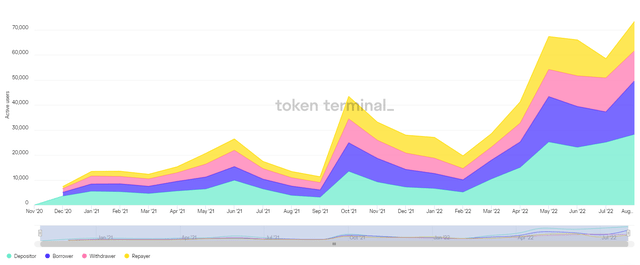
Active Users (Token Terminal)
The active users of the platform has been consistently growing even during the crypto contagion selloffs. Since the end of 2021, the number of depositors has tripled and borrowers have doubled.
| December 2021 | August 2022 | Change | |
|---|---|---|---|
| Depositors | 7,155 | 28,221 | 294.42% |
| Borrowers | 7,088 | 21,423 | 202.24% |
| Withdrawers | 6,539 | 12,008 | 83.64% |
| Repayers | 7,117 | 11,630 | 63.41% |
Source: Token Terminal
In addition to the rise in usage of the network as a lending protocol, holders of the token has increased by about 17% year to date from 103k holders to over 121k:
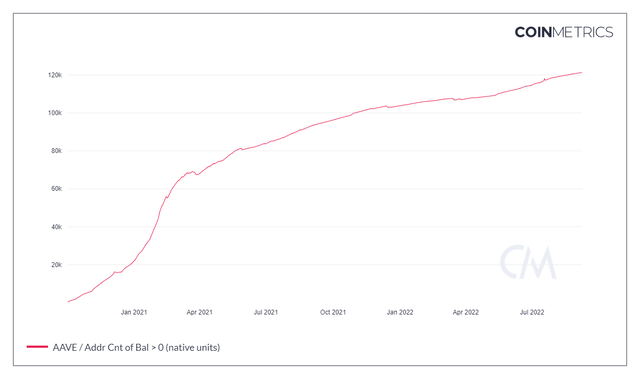
AAVE Token Holders (CoinMetrics)
Network Footprint
Earlier this year, Aave launched Aave V3 in an attempt to branch out from Ethereum lending into other networks including Avalanche (AVAX-USD), Polygon (MATIC-USD), and Optimism (OP-USD), among others. Since the integration of those additional blockchains, we’ve seen a fair amount of liquidity added from the new networks
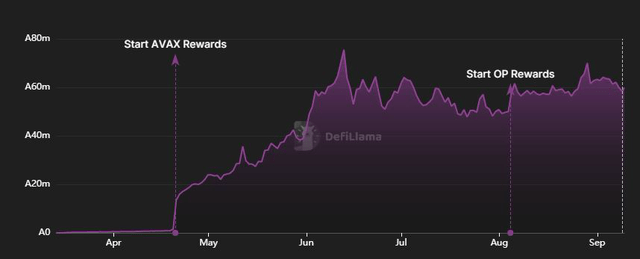
Aave 3 TVL (DeFi Llama)
This puts total value locked (or TVL) through the Aave protocol at over $6.3 billion. While ETH is still the dominant network, the TVL breakout by blockchain shows growing interest in alternative chains:
| Chain | Approximate TVL |
|---|---|
| Ethereum | $5 billion |
| Avalanche | $736 million |
| Optimism | $397 million |
| Polygon | $389 million |
| Others | $40 million |
Source: DeFi Llama, as of 9/9/22
For a bit more context, the alternative networks have seen growth in native unit deposits when adjusting for USD price declines in the coins themselves:
| Native Units | June 1, 2022 | September 9, 2022 | Change |
|---|---|---|---|
| Aave 2 (ETH millions) | 4.51 | 3.41 | -24.39% |
| Aave 3 (AVAX millions) | 48.85 | 59.90 | 22.62% |
| Aave Total (ETH millions) | 5.16 | 3.88 | -24.81% |
Source: DeFi Llama, as of 9/9/22
I chose June 1st as a starting point because it gives us a couple of months from the start of V3 when new networks were on-boarded. This was also during the thick of the crypto contagion following the collapse of Terra (LUNC-USD) and various CeFi platforms. What this tells us is that while the TVL is down since the beginning of the summer, the growth is in the V3 update.
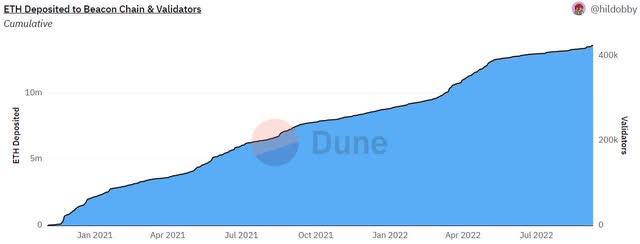
Dune Analytics
This should be unsurprising as roughly 1 million ETH has been staked in Beacon in anticipation of the merge from PoW to PoS since the beginning of June, thus opening the door for different currencies to be pooled through Aave.
Other Catalysts
This week, a proposal was approved by the Aave community to grant a little over $16 million in retroactive funding to the development team that worked to build out Aave V3. The vote received strong support as evidenced by receiving more than twice the required 320k votes to pass. In my view, grants like this can help foster greater interest in protocol improvements from the larger developer community.
In late July, the Aave community also approved a vote to launch an Aave native stablecoin (GHO-USD). While full implementation of that initiative will take more time, the market for stablecoins has grown tremendously over the last year with roughly $12 billion in assets a year ago to over $100 billion now.
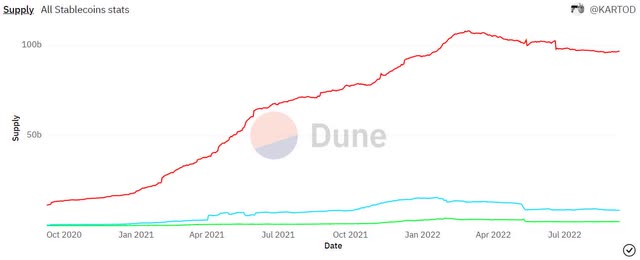
Dune Analytics
Tokenomics & Supply
The token itself functions as both a utility token and a governance token. Holders of AAVE coins can get better rates on fees when they deposit AAVE as collateral. The holder breakout has the top 100 addresses accounting for 86% of the token supply.

Holder breakout (Etherscan)
10% is held by the ecosystem reserve with an additional 14% staked. This level of top wallet concentration puts AAVE roughly in line with lending protocol peers like Compound (COMP-USD) which has about 90% of token supply in the top 100 addresses.
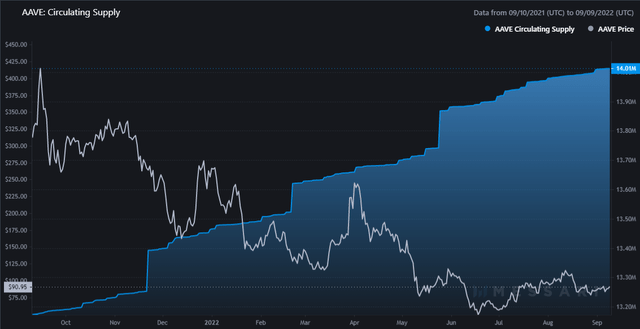
Circulating Supply (Messari)
As the circulating supply has moved up gradually over the last year, the price of the AAVE token has declined. However, with a total supply of 16 million tokens, 88% of the supply is now circulating and inflation risk is much lower than lending protocol peers:
| Market Cap Rank | Lending Protocol | Circulating Supply |
|---|---|---|
| 42 | Aave | 88% |
| 100 | Compound | 72% |
| 153 | SushiSwap Kashi (SUSHI-USD) | 51% |
Source: CoinMarketCap
From a coin supply dynamic, AAVE is a token that should benefit greatly from a broad rise in crypto asset values given the level of holders, network activity, and chain diversification.
Risks
Like all cryptocurrencies and tokens, AAVE carries risk from both volatile price swings and potential regulatory headwinds. DeFi is still an inherently risky space to invest and token buyers should be prepared for significant capital losses if the broad crypto market takes another leg down or if government regulations become too burdensome for these protocols to operate.
Summary
The Aave protocol is branching out from just an Ethereum-focused lending protocol to other blockchains. I think the growth in token holders and active platform users is a good thing for network adoption. As a utility and governance token, this justifies the case for organic token demand. Since the circulating supply of the AAVE tokens is now 88%, there isn’t much of a dilution risk to current token holders. I’ve taken a position in AAVE in the BlockChain Reaction portfolio and I believe AAVE will outperform other crypto assets when crypto winter is in the rear view mirror.


Be the first to comment